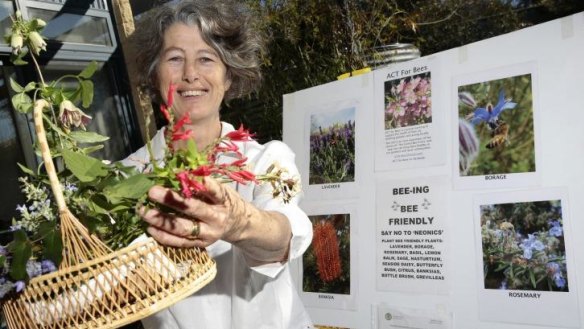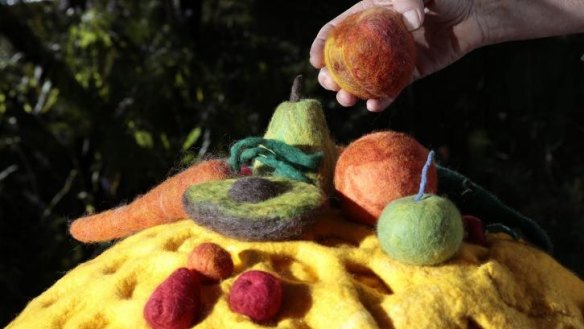It's a matter of survival: ACT group fights to save the honey bee

Although a bee can go on a 10-kilometre meander for food, it makes a beeline home avoiding obstacles and measuring the distance even though its brain is the size of a sesame seed, says Professor Mandyam Srinivasan, from the Queensland Brain Institute at the University of Queensland.
Srinivasan was talking about his neural science research into bees at the National Portrait Gallery last month. He explained that although a bee can go on a 10-kilometre meander for food, it makes a beeline home avoiding obstacles and measuring the distance even though its brain is the size of a sesame seed. adds that bees perceive the world in 3-D and have good colour vision but cannot see red.
Meanwhile, in her garden in Duffy, Julie Armstrong has bee-friendly winter-flowering pineapple sage with its scarlet flowers and the edible herbs borage, thyme, rosemary, mint, lavender, oregano and perennial basil. She also grows a range of nectar-rich native callistemons, banksias and grevilleas and raspberries, strawberries and citrus. Rocket, lettuces, coriander, endive, and dandelions are allowed to flower as extra good sources of pollen for a range of bees and insects.

During our visit to the Armstrong garden a bee obligingly flies towards potted citrus and a yellow and brown honeyeater darted around plants near the gurgling water feature.
When Julie travelled to Europe in 2013, she became aware of the global bee crisis and of a two-year ban on neonicotinoid pesticides because of their effect on the bee and honey industry. Many of these pesticides are used in Australia on farms, in gardens and around schools and city landscapes.
Upon her return to Canberra, where she has lived for 21 years, Julie noticed that gardens had changed from having bee-nourishing flowers to being "maintenance free" with rocks and grasses. Some local gardeners had bean plants that had flowered but not set because they had not been pollinated.
Last year, Julie started the ACT for Bees group. Members include bee-keepers and others interested in biodynamic gardening. Their aim is to raise awareness of the importance of Apis mellifera, the honey bee, for more than its honey. However, the group does have access to delicious honey from members including Warren who keeps a Warre hive, Brendan's honey from Rivett and James's spicy honey from Waramanga.
Warre beehives were named after their inventor Abbe Emile Warre (1867-1951) who responded to a bee-keeping decline in France by experimenting with 350 hive designs. Warre is a divisible hive, also called the people's hive as it was designed so any person with basic tools and woodworking skills could make their own from locally sourced timber.
From studying the book Global Hive: Bee Crisis and Compassionate Ecology, by Horst Kornberger (in Woden Library), Julie learnt that bees are responsive to UV light, wind speed, sun's direction and have five eyes including two large compound eyes with thousands of hexagonal lenses on each. She was inspired by the wonder of bees and how they work co-operatively for the good and wellbeing of the whole hive.
Among fruits and vegetables that are totally dependent on honey-bee pollination are apples, almonds, cucumbers, avocados, blueberries, pumpkins, rockmelons, broccoli, brussels sprouts, cabbage, carrots, cauliflower, celery, mustard and onions (according to the Rural Industries Research and Development Corporation 2008).
This knowledge led to Julie's creating a "global hive" of felted wool and silk The global hive covers a gym ball and in its pockets are pollination-reliant fruits and vegetables, also made by Julie in felt.
The Bumblebee Conservation Trust in the UK has found that in winter bumblebees (Bombus terrestris) are able to maintain winter colonies by foraging on arbutus (the strawberry tree), Clematis cirrhosa, mahonia and winter-flowering honeysuckles, and Julie has Canberra cuttings of these plants.
Meanwhile, if you get a chance to walk through the entry cutting to the Village Centre at the National Arboretum Canberra, have a look at the glass panels set in the gabion walls. Architect Peter Tonkin tells me the gabon baskets are hand-filled with Wee Jasper porphyry. Some glass panels have been inset into the wall and these are etched with plants and also bees by artist David Lancashire. One of these works references a 100-million year-old bee fossil found in Burmese Amber. I really liked this link between the age of bees and today's Canberra. The panel was pointed out to me a fortnight ago by chance on one of my many visits to the arboretum.
Susan Parsons is a Canberra writer.
Restaurant reviews, news and the hottest openings served to your inbox.
Sign up